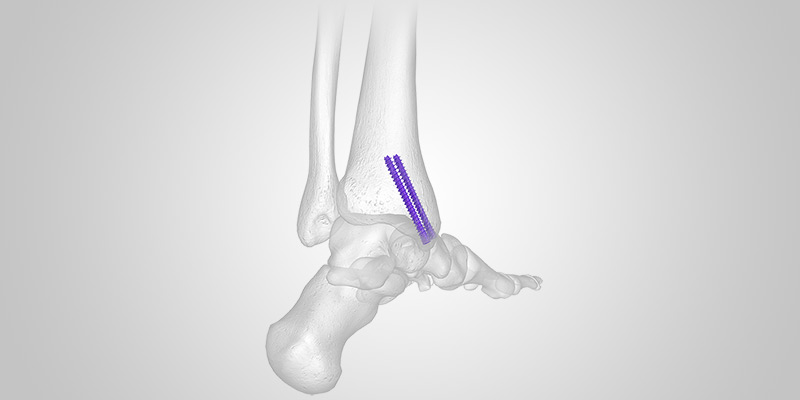
New Biomechanical Study Finds Acutrak Headless Compression Screw Potentially Favorable for Medial Malleolus Fractures
July 11, 2018
The biomechanical study found that the Acutrak fully threaded headless compression screw with continuously variable thread pitch is potentially favorable over partially threaded cancellous screws for the compression of medial malleolus fractures.
A recent study published in the Journal of Clinical Biomechanics compared Acutrak 2–4.7 mm headless compression screws and 4.0 mm partially threaded cancellous screws and found Acutrak was the potentially favorable option for the fixation of medial malleolus fractures.
The investigator-initiated biomechanical study was led by Robin Z. Cheng of the University of California Davis Medical Center. Additional contributors were from UC Davis and the Stanford University School of Medicine. The principal investigator of the study was Derek F. Amanatullah, MD, PhD of Stanford. The work was funded in part by Acumed.
The study utilized 18 synthetic tibiae, each cut 18 cm from the tibial plafond, to simulate medial malleolar fractures. Each tibia was then randomly assigned fixation with either two Synthes parallel, partially threaded, unicortical 4.0 mm cancellous screws or two parallel, 45 mm Acutrak 2–4.7 mm screws, with nine tibiae in each group. To simulate tensile force on the fracture fragment, a single steel slotted spring pin was inserted through the fragment and attached to a steel cable hooked to a test machine actuator. Force was applied with an initial 50N then pulled at a rate of 10 mm per minute. Distal and lateral movement was measured to failure via spherical markers placed on the anterior portion of the medial malleolus and monitored with a CCD camera. Clinical failure was defined as 2 mm of intrarticular fragment displacement, with construct stiffness measured in both distal and lateral directions.All tests resulted in both distal and lateral displacement of the medial malleolar fragment. Construct stiffness results for Acutrak 2–4.7 mm screws were significantly greater than the 4.0 mm cancellous screws, with mean stiffness results at:
- Proximal–Distal
- 4.0 mm Cancellous Screws: 668 N/mm
- Acutrak 2–4.7 mm Screws: 1,699 N/mm
- Medial–Lateral
- 4.0 mm Cancellous Screws: 281 N/mm
- Acutrak 2–4.7 mm Screws: 604 N/mm
It is important to note that synthetic tibiae were used in this study rather than cadaveric bone. The Acutrak 2 screws, however, were noted by the authors as having a larger diameter, which would engage more bone than the 4.0 mm screws and potentially result in lower bone and screw stress.
Additionally, artificially simulated axial loading in a single loading mode was observed in this study as a means to demonstrate the force exerted by the deltoid ligament on the medial malleolus without taking other soft tissue structures into account. And the tensile stress was modeled as a singular force, rather than cyclical loading, which would model stress over time. Key findings of the Cheng et al study were in favor of using Acutrak 2–4.7 mm screws in medial malleolar fractures:
- When subjected to a single load to failure, the headless compression screw construct provides over two times greater stiffness in both the proximal-distal and medial-lateral directions. Additionally, the headless compression screw construct sustains higher forces prior [to] reaching 2 mm lateral displacement, with 2 mm of displacement defined as clinical failure.1
- …our findings suggest that a headless compression screw construct provides a stiffer construct than a parallel unicortical cancellous screw construct. The headless compression construct sustains higher load prior to reaching clinical failure in the lateral direction.1
- The increased resistance to both axial and shear loading, greater interfragmentary compression, and low-profile design of the Acutrak 2 headless compression screw may decrease the rate of clinical failure and reduce the need for revision surgeries, thus being a potentially improved option for fixation of horizontal medial malleolus fractures.1
1. Cheng RZ, Wegner AM, Behn AW, Amanatullah DF. Headless compression screw for horizontal
medial malleolus fractures. Clin Biomech. 2018;55:1–6.
Additional video resource: Medial Malleolar fracture cadaveric lab with Nicholas Abidi, MD